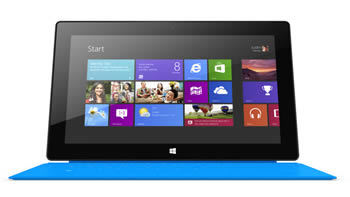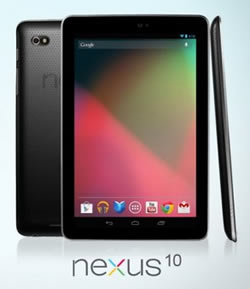Difference between Microsoft Surface RT and Nexus 10
Key Difference: The Microsoft Surface RT is a tablet that features a 10.6-inch TFT HD capacitive touchscreen with approximately 148 ppi density. The screen affords the true 16:9 aspect ratio. However, the OS is not compatible with old Windows PC programs. The Nexus 10 is a tablet computer running Android 4.2 (also named Jelly Bean) operating system, which was released with it. It was developed in collaboration with Samsung.
 The market for bigger, better and more able smartphones is increasing. People are getting bored with the regular phones that would just place calls or send text message, now the phones need to be able to do many other things to even be considered as a choice. The phone should allow the users to surf the internet, check e-mails, record their schedules, find things on the internet, understand their speech, etc. They have become less phones and more personal secretaries. Now, it goes even further and tablets have come into the picture. Tablets have the portability of a phone and the functions of a laptop. Some tablets even allow users to place calls. Microsoft, which was originally a Desktop manufacturer, has now shifted focus on creating smartphone operating systems, laptops, and even tablets. The Microsoft Surface RT was launched in November 2012.
The market for bigger, better and more able smartphones is increasing. People are getting bored with the regular phones that would just place calls or send text message, now the phones need to be able to do many other things to even be considered as a choice. The phone should allow the users to surf the internet, check e-mails, record their schedules, find things on the internet, understand their speech, etc. They have become less phones and more personal secretaries. Now, it goes even further and tablets have come into the picture. Tablets have the portability of a phone and the functions of a laptop. Some tablets even allow users to place calls. Microsoft, which was originally a Desktop manufacturer, has now shifted focus on creating smartphone operating systems, laptops, and even tablets. The Microsoft Surface RT was launched in November 2012.
The Microsoft Surface RT is a tablet that features a 10.6-inch TFT HD capacitive touchscreen with approximately 148 ppi density. The screen is pretty decent in terms of resolution and shows clear, sharp images. The screen affords the true 16:9 aspect ratio which matches most movies and shows, eliminating the black bars that pop up. The tablet runs on the Windows OS, but has a huge lacking feature. The OS is not compatible with old Windows PC programs such as VLC, Photoshop Elements, etc. This is one of the reasons for the tablet not being so popular even after the amazing design and other attractive features. In order to run the old PC programs, one would require Windows 8 with an Intel processor, which is offered in the Microsoft Surface Pro.
The device has a slab form that makes it look thicker and heavier than it actually is. The device is only 9.4 mm thick, same as the iPad; however, the slab form that has not been tapered towards the end makes it seem thicker. The tablet is a little heavier compared to other devices because of the extra inches on the screen. The device is quite slick, which makes it easier to grip but more prone to slipping through the fingers. The device comes with a built-in kickstand that helps it stay upright when placed on a surface. The device is covered in a VaporMg casing, which according to the company, makes the device scratch and water-resistant. The device also has an intriguing feature, which is a cover that doubles as a keyboard. The sleek and flat keyboard has an aesthetic appeal and is also productive.
On top of the device when facing front in landscape mode, there is an ambient light sensor along with the front facing 1.2 MP camera. On the bottom bezel is the Windows Home sensor that takes the user to the start screen or the last app accessed. On the right side of the device, there is a speaker grille, a Micro-HDMI port, a full USB 2.0 port, and the power port. The left side has an additional speaker grille, a headphone jack, and a volume rocker. The kickstand is said to be a bit difficult for some people, while other claim that the stand was pretty smooth and easy to access. Under the stand, resides the microSD port, while there are magnets on the bottom to attach the Touch and Type keyboard covers. The device also has a 1.2 MP rear camera, in case anyone would like use it take photos.
The tablet is powered by a 1.3 GHz Quad-core Cortex-A9 and comes in 32 and 64 GBs variants. The device feature 2 GB RAM. The processor provides enough power to allow the swiftly shifting between apps and windows. The tablet supports 802.11 a/b/g/n Wi-Fi support, Bluetooth 4.0, a gyroscope, an accelerometer, and a built-in compass, but no GPS. The device houses a 31.5 W-h battery that drained pretty quickly according to CNET. The main problem that comes with this device is that it is less of a tablet and more of an even more portable laptop. The design is obviously appealing, but in terms of features and price, maybe going for Microsoft Surface Pro.

Among the number of various companies launching phones based on Google’s Android, Google has also launched its own line of smartphones based on Android, called the Google Nexus. Each device in the Nexus line is produced via collaboration between Google and a leading original equipment manufacturer (OEM) partner. The Nexus devices in general have an advantage over other devices in that the Android in the Nexus devices is pure, i.e. the Android does not have any manufacturer or wireless carrier modifications to it, such as a custom graphical user interface. The Android also has an unlockable bootloader to allow further development and end-user modification, all of which is usually blocked on other Android smartphones.
The Nexus 10 is a10-inch tablet computer running Android 4.2 (also named Jelly Bean) operating system, which was released with it. It was developed in collaboration with Samsung. It is Google’s second tablet, directly following the Nexus 7. It features a 10.1-inch, 2560×1600 pixel display, which at the time of its release was the highest resolution display for a tablet. The Nexus 10 features a Samsung Exynos 5250 system on chip, a dual-core 1.7 GHz Cortex A15 central processing unit and a quad-core ARM Mali T604 graphics processing unit. The Nexus 10 was launched in two storage sizes, 16 GB and 32 GB
The Nexus 10 features Photo Sphere, a new camera technology that allows one to take 360 deg Panorama shots. The tablet also features a quick settings menu, allows for application of widgets on the lock screen, as well as gesture typing; an updated version of Google Now; and multiple user accounts for tablets. The tablet offers a new share and customize feature that allows multiple users to create their own profile and customize it according to their own needs. The tablet offers a 5 MP rear camera and a 1.9 MP front camera for video chatting. The tablet does not support SIM capability. The device also allows nine people to chat simultaneously using Google Hangouts. The Nexus 10 is available for approximately USD 399, with the price varying depending on the model.
The information for the detailed table about the two devices has been taken from the Microsoft website, Google website and GSMArena.com.
|
|
Microsoft Surface RT |
Nexus 10 |
|
Launch Date |
November 2012 |
November 2012 |
|
Company |
Microsoft |
Google; designed in collaboration with and manufactured by Samsung. |
|
Size |
274.6 x 172 x 9.4 mm |
263.9 x 177.6 x 8.9 mm (10.39 x 6.99 x 0.35 in) |
|
Display |
10.6 inches TFT HD capacitive touchscreen |
Super PLS TFT capacitive touchscreen, 16M colors |
|
Screen |
1366 x 768 pixels (~148 ppi pixel density) 16M colors |
2560 x 1600 pixels, 10.1 inches (~299 ppi pixel density) |
|
Protection |
VaporMg casing |
Corning Gorilla Glass 2 |
|
Weight |
680.4 grams |
603g (1.33 lb) |
|
2G Network |
N/A |
N/A |
|
3G Network |
N/A |
N/A |
|
4G Network |
N/A |
N/A |
|
GUI |
Windows RT |
Pure Android |
|
CPU speed |
1.3 GHz Quad-core Cortex-A9 |
Dual-core 1.7 GHz Cortex-A15 |
|
GPU |
ULP GeForce |
Quad-core Mali T604 |
|
OS |
Windows RT |
Android OS, v4.2 (Jelly Bean), upgradable to v4.2.1 (Jelly Bean) |
|
Chipset |
Nvidia Tegra 3 T30 |
Exynos 5250 |
|
RAM |
2 GB |
2GB RAM |
|
SIM Size |
N/A |
N/A |
|
Internal Memory |
32/64 GB |
16/32 GB storage |
|
Expandable Memory |
Up to 64 GB |
None |
|
Sensors |
Accelerometer, Gyro, Compass, Ambient light sensor |
Accelerometer, gyro, proximity, compass, barometer |
|
Connectivity |
Wi-Fi, Wi-Fi direct, Bluetooth, USB. |
WiFi 802.11 b/g/n (MIMO+HT40) Bluetooth NFC (Android Beam) Dual side NFC Micro USB Magnetic Pogo pin charger Micro HDMI 3.5mm headphone jack |
|
Data |
WLAN, Bluetooth, USB. |
WiFi, NFC, USB |
|
Speed |
- |
- |
|
WLAN |
Wi-Fi (802.11a/b/g/n) Wi-Fi Direct, dual-band |
Wi-Fi 802.11 b/g/n, Wi-Fi Direct, DLNA |
|
Bluetooth |
Bluetooth v4.0 with A2DP |
Bluetooth v3.0 with A2DP |
|
USB |
USB v2.0, USB Host support |
Micro-USB v2.0 |
|
Primary Camera |
1.2 MP |
5 MP, 2592х1936 pixels, autofocus, LED flash |
|
Secondary Camera |
1.2 MP |
1.9 MP |
|
Video |
720p @ 30fps |
1080p@30fps |
|
Camera Features |
Geo-tagging |
Geo-tagging, touch focus, face detection, video-calling |
|
Sound Enhancement |
Two microphones, Stereo speakers |
No |
|
Audio supported formats |
MP3/ WAV/ eAAC+ player |
MP3/WAV/eAAC+/WMA/ Flac player |
|
Video supported formats |
MP4/ DivX/ Xvid/ H.264/ H.263 player |
MP4/H.264/DivX/ WMV player |
|
Battery Capacity |
31.5 W-h |
Non-removable lithium-ion polymer 9,000 mAh battery |
|
Talktime |
- |
N/A |
|
Standby Time |
- |
- |
|
Available Colors |
Dark Titanium |
Black |
|
Messaging |
Email, Push Email, IM |
Email, Push Email, IM, RSS |
|
Browser |
HTML5 |
HTML5 |
|
Radio |
No |
No |
|
GPS |
Yes |
Yes, with GLONASS |
|
Java |
- |
None |
|
Additional Features |
|
|
Image Courtesy: microsoft.com, androidheadlines.com









Add new comment